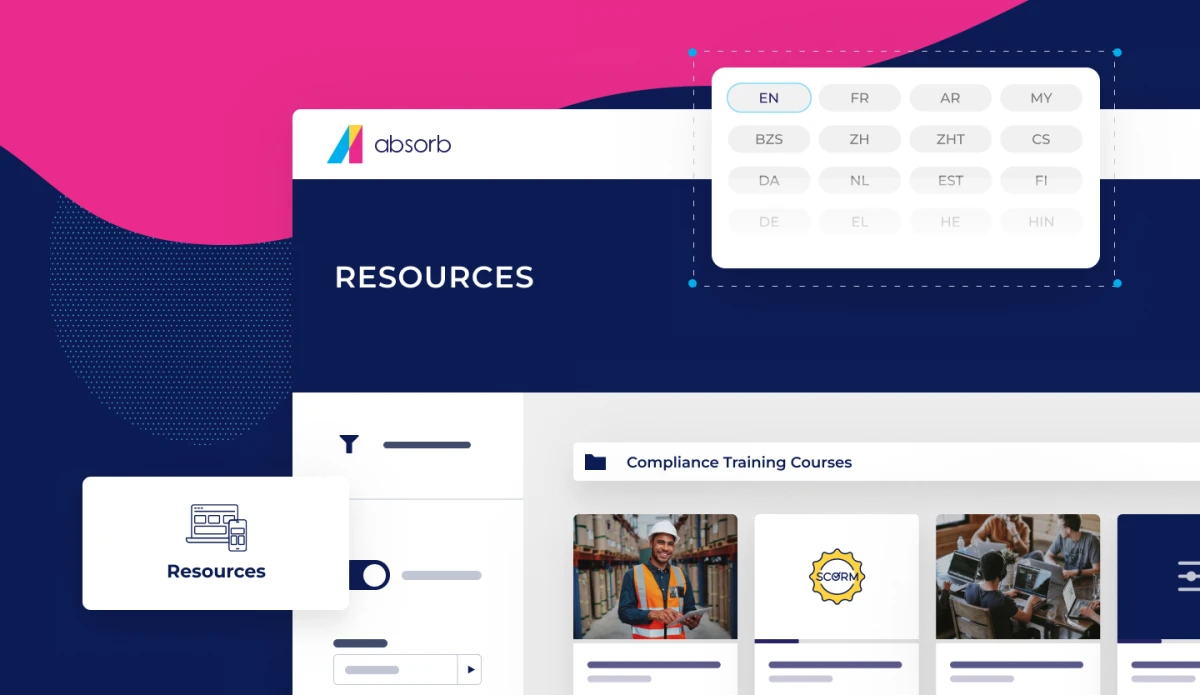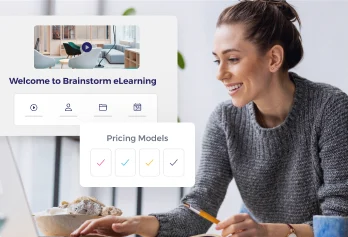Compliance training—the process of educating employees on the laws, regulations and policies that govern their roles—plays a pivotal role in the ongoing success and sustainability of businesses across different sectors. The larger the business, however, the harder it is to effectively manage compliance training at scale, ensuring that the entire workforce receives up-to-the-minute information.
But despite the importance of compliance, it can often be hard to keep your workforce engaged through the training. According to Brandon Hall Group’s Compliance Training Study, “only about one-third of companies consider their compliance training efforts to be effective.”1 Which begs the question, how can your business make sure that your compliance training makes an impact on your workforce?
This is where Enterprise Learning Management System (Enterprise LMS) solutions come into play, offering a platform to deliver content, track progress and report on employee performance in training. An LMS like Absorb is designed not only to address the challenges of managing compliance at scale, but also to streamline the process, enhance accountability, and build a culture of compliance throughout your organization. In this article, we’ll look into some of the challenges posed by large-scale compliance training as well as the role your LMS can play in achieving your compliance training goals.
Understanding compliance training needs
Compliance training covers a broad range of requirements with an emphasis on legal and regulatory factors. Most large enterprises operate according to a set of laws and regulations that vary from industry to industry, as well as between regions. As a result, employees need to be trained across a number of topics, including industry-specific regulations, corporate governance, data protection, ethical conduct, and more. It's not just about memorizing a list of rules and guidelines; compliance training is about fostering a deep understanding of the legal and regulatory standards that impact the day-to-day roles of your employees. As laws and regulations change, your compliance training needs to adapt with them. This requires a dynamic approach to corporate training that addresses your sector’s legal and regulatory requirements, creating a culture of compliance and ethical behavior within your organization.
Non-compliance can have far-reaching consequences for your business that underscore the need for a comprehensive approach to compliance training. These can range from legal penalties and fines to reputational damage and loss of trust from clients and customers. Large organizations frequently operate in highly regulated industries, and compliance violations can have financial and legal ramifications. By providing compliance training, your business can mitigate risk and safeguard the reputation of your brand.
Key features and functionalities of enterprise LMS for compliance
Using an LMS for compliance training can help your business ensure the effective management, tracking, and delivery of compliance training throughout your organization. Here is an in-depth breakdown of essential features and functionalities that enterprise-level organizations should seek in an LMS for large-scale compliance training:
SCORM compatibility: SCORM, which stands for "Sharable Content Object Reference Model," is a set of technical standards for eLearning software products. A SCORM-compliant LMS ensures compatibility with a wide range of eLearning content and authoring tools, allowing for easy integration and content reuse.
Tracking and reporting: With large numbers of employees requiring training, businesses must be able to track learners’ progress with data-driven reporting and analytics functionality. An LMS can monitor the completion status of modules, measure assessment scores over time, and provide managers with automated reports on compliance status.
Audit trails: Audit trails are a chronological record of activities and events within an LMS, providing a detailed history of user interactions, system changes, and content access. They play a critical role in compliance training, providing a transparent record of user activities and demonstrating regulatory compliance, and accountability.
Compliance library : Employees need a place where they can quickly and easily access compliance documents, policies and regulations. Absorb LMS, for example, features the content library Trailant which can act as a centralized repository where your workforce can reference training materials and documentation wherever they are with all content made searchable and mobile accessible.
User and role management: A robust user management system with role-based access controls allows administrators to assign roles and permissions to users based on their responsibilities within the organization. This means employees only see compliance content that’s relevant to them and makes it easier to find the information they need at short notice.
Automated reminders: An automated system of reminders and notifications can help inform users about upcoming compliance training requirements, deadlines, and course completions. A fully featured LMS can keep track of roles and timelines, ensuring your team is always up to date with compliance requirements.
Certification and recertification: Your LMS should allow for the creation and management of certification programs with reminders for retraining or recertification, whether it’s to a handful of learners or department wide, on an annual basis, or as and when regulations change. With AI-driven prompts, learners can be guided to the next relevant course they need to complete.
Accessibility and multilingual support: With large organizations, it’s important that everyone is able to view and interact with your compliance training content. For global organizations, multilingual support is essential to accommodate learners who speak different languages. It’s also important to provide comprehensive accessibility options for people with disabilities.
With these LMS features in place, you can create a compliance training program that’s tailored to the unique needs of your business and your workforce.
Customizing compliance training content in your LMS
As we’ve discussed, every business operates within a unique framework of industry standards, regulatory requirements, and internal policies. As a result, compliance training content must be carefully crafted to address these specific needs. Tailored content ensures that employees receive role-specific training, reducing the risk of non-compliance.
Multimedia elements: Studies have found that learners absorb information more effectively when it’s presented in a variety of different formats.2 Dubbed “the multimedia effect”, this strategy can be useful for keeping learners engaged in topics that aren’t necessarily the most enthralling. By adapting your LMS to use a mixture of visuals, video, and audio you can make your compliance training content more engaging and memorable for your employees.
Interactive quizzes: Integrating quizzes and other gamified elements in your compliance training can be an effective way to assess learners' understanding of various compliance topics. Quizzes can act as checkpoints to reinforce key concepts. Be sure to provide feedback on quiz results, explaining correct answers and offering explanations for incorrect responses so that your team can learn from their mistakes.
Case studies: Real-life case studies are a useful way to illustrate compliance successes, failures, and ethical dilemmas in the workplace. If possible, it’s a good idea to encourage learners to discuss case studies in groups, fostering collaborative problem-solving and critical thinking. This interactive approach encourages the application of compliance principles.
Interactive simulations: Role-playing exercises and interactive simulations are a great way to immerse learners in realistic compliance scenarios, allowing them to make decisions and witness the consequences of their actions. Create scenarios where learners take on various compliance-related roles to help them understand different compliance-related perspectives and challenges.
Customization: Tailor your compliance training to align with the policies, procedures, and industry regulations of your business. To keep content relevant for learners, create easy-to-consume, bite-sized modules that can be customized to suit different departments or roles. This allows for personalized learning pathways for your team.
Stay up to date: Compliance regulations are always changing, so it’s vital that your training keeps pace. Be sure to update training materials regularly to reflect the latest legal requirements and industry standards.
Customized training content provides employees with the knowledge required to navigate the complex world of compliance and helps foster a culture of responsibility, promoting ethical conduct and aligning employees with your organization's regulatory goals.
Integration with compliance management systems
By integrating an enterprise LMS with your compliance management system, your business can enhance regulatory adherence, streamline tracking, and bolster reporting accuracy, ensuring a robust culture of compliance throughout your organization. This not only simplifies the management of compliance training but also gives you the ability to swiftly adapt to evolving regulatory landscapes, safeguarding your enterprise against potential risks and liabilities. With integrated data analytics, you can gain real-time insights into employee progress, identify areas requiring attention, and proactively address compliance gaps, thereby promoting a more agile and efficient approach to regulatory compliance.
Integration of an LMS with your compliance management system allows for the automatic exchange of crucial data, creating a seamless flow of information throughout your organization. Compliance-related training modules and materials mesh with your compliance management framework, meaning you can assign, monitor, and evaluate training initiatives quickly and easily.
When it comes to regulatory reporting, LMS integration offers a simple way to compile compliance data in one convenient place. Rather than manually entering data into your system, your team can generate accurate, real-time reports on your organization's compliance status, allowing you to identify issues and take corrective actions. Regulatory reporting becomes a swift and efficient process, guaranteeing that your business is always audit-ready.
8 steps to selecting the right enterprise LMS for compliance
When choosing an enterprise LMS for your compliance needs, a systematic evaluation process can help you make an informed choice. Here's a step-by-step guide to help you make the right decision:
Assess your compliance requirements: Begin by identifying the specific compliance needs of your organization. Determine the regulations, industry standards, and internal policies that your LMS must support. Consider factors like the number of employees, geographical spread, and the nature of compliance training required.
Scalability and flexibility: Your LMS needs to be able to grow as your business grows. Look for a platform that can adapt to changes in your organization's size, training requirements, and compliance landscape to ensure the best long-term value.
Content creation and management: Compliance requirements are always changing, so you need an LMS that allows for the easy creation, management, and customization of training content. Work with a provider that can take care of the basics, so you focus on the more important aspects.
User experience: Employees should be able to navigate the LMS, access training materials, and track their progress from a variety of devices, especially mobile. As such, it’s important to find an LMS with an intuitive user interface. You might never be able to make compliance training fun, but you can remove barriers that improve the learner’s overall experience.
Security and data privacy: Compliance training often involves handling sensitive data. Make sure the LMS you choose meets security and data privacy standards, such as GDPR or HIPAA, to safeguard your employees’ information as well as your organization’s. With security top of mind, the LMS you choose should have a range of permission settings, so HR, legal, partners, auditors and learners alike can use the system with ease and peace of mind.
Cost and ROI: Consider the cost of implementation, including licensing fees, maintenance, and support. Weigh this against the potential ROI in terms of reduced compliance violations, improved performance, and streamlined processes.
Trial and demo: Getting hands-on experience of an LMS will give you a feel for its functionality and, perhaps more importantly, its suitability for your organization. Getting employees to complete their compliance training is already a challenge. You know your team best. A trial will give you an opportunity to understand whether the software in question will fit the needs of your team. Whenever possible, request a trial or demo of the LMS to see if it’s the right fit for you and your team.
Real-world success stories: Symend, a company that offers behavioral science and data-driven insights for enterprise clients, has had great success using Absorb LMS to facilitate and track compliance training. Symend’s growth-minded learners received training in a SOC 2-compliant LMS and achieved a 100% completion rate for company compliance training. “From diversity and inclusion training to cybersecurity, using Absorb LMS to deliver training has kept us 100% compliant on training for important workplace issues,” says Mark Brown, VP of Sales Operations at Symend. Read more about the wins Absorb LMS helped Symend achieved here.
Another real-world case study comes from the healthcare industry. When a large university hospital came to Absorb, they were looking for a way to manage annual recertification for hundreds of hospital employees. Through automated enrollments and certification expirations, the administrators were able to automatically enroll, notify, and track the progress of hundreds of employees as they renewed their training year-on-year.
Measuring the ROI of compliance training with an enterprise LMS
In order to gain a holistic view of the success of your compliance training, it’s helpful to measure the ROI of your training against several Key Performance Indicators (KPIs) that gauge your organization's overall financial health and reputation. KPIs for tracking the ROI of compliance training include things like completion rates—the percentage of employees successfully finishing training—as well as compliance violations, measuring the reduction in compliance-related infractions. Audit success rates highlight your training's impact on regulatory inspections, while cost savings stem from fewer violations and legal actions. Employee feedback, knowledge growth, and incident reduction provide insights into training effectiveness, and engagement metrics demonstrate employee involvement. It’s also possible to calculate the time saved due to fewer incidents and the avoidance of legal actions.
Measuring ROI helps demonstrate the tangible value of your compliance training to stakeholders. By quantifying the financial impact of compliance initiatives, you can show that compliance is not merely a regulatory obligation but a strategic investment for your business. Moreover, it helps in justifying ongoing investments in training programs, technology, and resources by showcasing the reduction in compliance violations, incidents, legal actions, and the associated cost savings.
Challenges and solutions in enterprise LMS implementation
The implementation of LMS solutions for enterprise-scale compliance training can be accompanied by several common challenges:
Resistance to change: With employees pulled in so many directions at large organizations, some may resist adapting to new technology and training methods, seeing learning as something that’s pulling them away from their day-to-day responsibilities. In these instances, it’s important to communicate the benefits of training clearly. Be sure to make compliance training bite-sized and easily digestible, and ensure that you have buy-in from leadership.
Keeping training content current: Compliance regulations are continuously evolving, making it challenging to keep your training materials up to date. To tackle this, perform regular content audits and collaborate with compliance experts to ensure that your training stays relevant.
Complex tracking and reporting: With large numbers of employees and constantly changing regulations, tracking, and reporting compliance progress can be complex and time-consuming for HR managers and learning and development (L&D) admins. Make sure you choose an LMS with real-time reporting and data analytics capabilities to streamline this process.
Balancing customization and scalability: Striking the right balance between customized training and scalability can be a challenge for businesses with large workforces. The right LMS can offer flexibility and scalability options, reducing the time it takes to tailor training programs for your team.
Protect your business with enterprise scale compliance training
Compliance training poses a significant challenge to (L&D) managers at large organizations. With industry regulations and requirements constantly changing, training content and documentation need to be updated continuously. Employees need to be certified and recertified regularly to comply with the standards associated with their roles, and on top of this, compliance isn’t always the most engaging topic for learners.
A robust, LMS-powered eLearning program can be a smart way to address the challenges inherent in compliance training, offering a way to deliver customized training programs at scale, with intelligent features to engage learners and support information management. By following some of the best practices we’ve laid out in this article, your business can foster a culture of compliance throughout your team, safeguarding against legal and financial penalties and building trust with clients and customers.
If you’re interested in finding out how an LMS can make compliance training easy and accessible, get in touch with our expert team or arrange a demo today.





